Installation of septic tank “Topas”: do-it-yourself installation + service rules
When arranging an autonomous sewage system for a suburban area, many owners solve the issue of biochemical wastewater treatment by constructing systems based on stations, including Tapas.
But how does this treatment plant work and how is the installation of the Topas septic tank carried out? We will consider these issues in detail in our article, focusing on the step-by-step process of installing a septic tank.
We also highlight the main advantages and disadvantages of this type of construction for the disposal of sewage and the features of its maintenance, supplementing the article with step-by-step photos and useful video recommendations.
The content of the article:
The principle of operation of the bio-treatment system
Septic Topop is a competently designed system of biochemical sewage treatment, functioning due to the work of the main skeleton - anaerobic and aerobic bacteria. The chemical side of the process is the oxidation of the waste mass by bubble oxygen, artificially injected into the system.
The biochemical effect on sewage allows you to purify them as much as possible before discharge into the underlying soil, gutters or filtration fields.
The organic component of the waste mass is destroyed by microorganisms, the household component is destroyed by oxygen. As a result, the wastewater becomes almost transparent, and loses its tendency to decay and bacterial contamination.
The developed system complies with all generally accepted standards for wastewater treatment and is safe for the environment. Living inside interconnected compartments of aerobes and anaerobes by processing biological organics purify and lighten effluents by 98%.
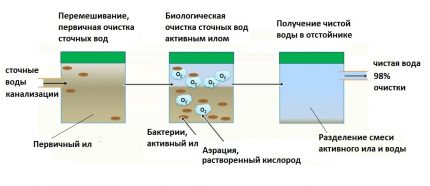
But the installation of the Topas septic tank is effective only when servicing the cottages in which they live all year round and operate the building at least 3-4 days a week.
After all, one of the key working conditions of a septic tank is the continuity of fluid intake. If the bacteria in the closed chamber do not receive food, they will die.
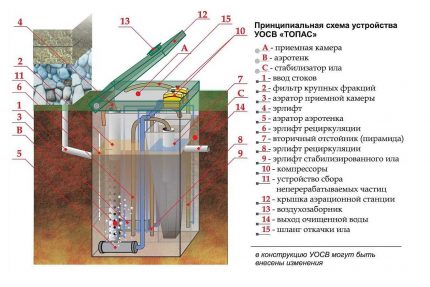
Each compartment performs one task assigned to it:
- First section. It receives wastewater coming from the sewer pipe and allows it to settle so that large inclusions settle to the bottom. Here, the mass is processed and oxidized by anaerobes. At the time of filling the compartment, a float switch is activated and gives a signal to the compressor for pumping waste into the second chamber.
- Second section. It is called aeration tank - a rectangular tank. It contains aerobic bacteria that eat and process organics. Oxygen is also supplied here, which is necessary for the final breakdown of organics and for the life of aerobes.
- Third section. Performs the function of a secondary sump. A “soothing” pyramid is installed inside the compartment. Here, the active biomass processing waste water is separated from the water.
- Fourth section. It carries out the final separation of water and the result of aerobic activity - activated sludge. The multistage water that has passed through the outlet leaves the compartment. Stabilized sludge settles at the bottom and accumulates there until removal. This moment should occur at least once a year.
At the first stage, the process of biological fermentation, launched by microorganisms, takes place. The main work on the decomposition of pollutants is carried out inside the walls of the second compartment. At the entrance of the second chamber, a coarse filter is installed, which catches clumps and hair that have not settled on the bottom.
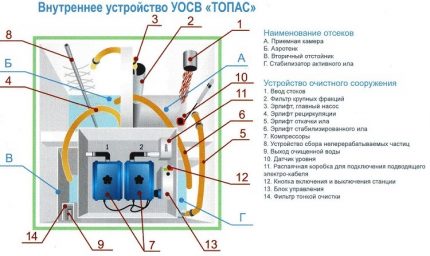
The movement of fluid from the third section to the fourth analogue can be carried out by gravity or stimulated by a pumping device.Depending on the natural or forced movement of waste masses, the station is equipped or not equipped with a drainage pump with a float switch.
The work of a seemingly complex device is based on the natural process of biological decomposition. The main thing is to ensure a continuous supply of oxygen and saturate the wastewater with a high dose of activated sludge, which is necessary for the intensive oxidation of organic substances.
In a separate hopper there are two compressor.
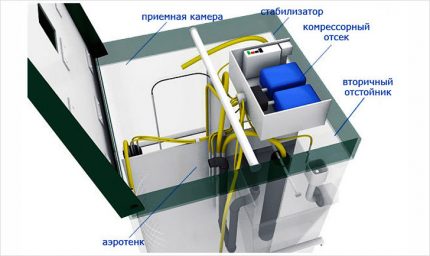
One of the main tasks of compressors is to activate the circulation of effluents from one chamber to another and mix them with activated sludge. It acts as a natural filter that binds solid particles and foreign bodies that have fallen into the septic tank.
There is another article on our website in which we examined in more detail the principle of work and device septic tank Topas.
Advantages and disadvantages of construction
The main advantage of the system is that each stage of cleaning takes place without environmental pollution.
Among the indisputable advantages of the system, it is also worth highlighting:
- High cleaning efficiency.
- Economical power consumption.
- No noise during operation.
- Ease of care.
Thanks to its compact dimensions, the treatment plant can be easily integrated even in a limited area.
A significant drawback of the structure is its volatility, which is associated with the operation of the compressor. The absence of an uninterrupted supply of electricity at the site makes the operation of a biological treatment plant impossible. Therefore, it is recommended to supplement the standard equipment of the station with an autonomous generator in case of interruptions.
It is also recommended to reduce water consumption during a prolonged power outage so as not to overfill the station with untreated wastewater, which can be disposed of spontaneously with an increase in volume and infect the soil.

A significant minus of such finished structures is the high cost. But when recalculating the savings in servicing by the suckers, it is immediately clear that the investment will pay off quickly.
A pleasant bonus to this will be the absence of unpleasant odors and the ability to close the structure relative to the house, which is so important when arranging a small area.
The subtleties of the proper septic tank selection
The models of this treatment plant on sale differ in power. Due to the wide range of models, it is possible to choose a design whose parameters will fully meet the needs of the customer.
For the arrangement of private houses, models with a numerical indicator of 5.8 and 10 are most often chosen. The Topop-5 model has a capacity of 1 cubic meter and is designed for volley release within 0.22 cubic meters.
Productivity Topasa-8 is 1.5 cubic meters, it copes with volley emissions in the region of 0, 44 cubic meters. The Topas-10 model successfully works with a capacity of 2 cubic meters, and its volume of volley emission is 0.76 cubic meters. meter.
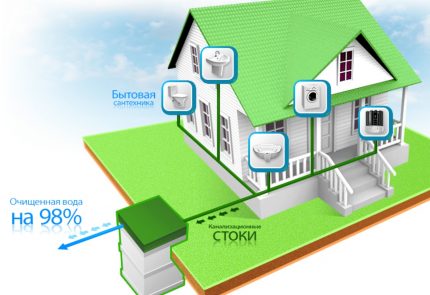
Topas-5 is chosen for the arrangement of an autonomous sewer system of small houses in which no more than five residents live. At the same time, a large number of plumbing is not taken into account.
For large cottages, the number of households in which reaches 8 people, choose a septic tank with increased productivity - the Topas-8 model.
If it is supposed to connect several washing machines and install a jacuzzi in addition to the shower cabin, choose the model of the next modification Topas-10.
In each model, there are two modifications that differ in height:
- Standard - involves the introduction of a sewer pipe at a depth of 0.4-0.8 meters.
- Long - for deepening the sewer pipe to 0.9-1.4 meters.
For areas where the geological section is represented by soils with low filtration properties, it is worth choosing models equipped with a pump. They provide a compulsory system for the disposal of treated effluents to the place of disposal. Such modifications are marked "PR".
Installation technology septic tank Topas
The process of installing the Tapas septic tank with your own hands includes a number of basic steps.
Stage # 1 - choosing a place and digging a pit
When installing the Tops septic tank with your own hands, it is important to clearly determine the location of the structure. According to the SES standards, the treatment plant must be installed, keeping a distance of five meters from the foundation of a residential building.
If a large area of the site allows you to place a septic tank at a remote distance from a residential building, then when laying a sewer pipeline, an inspection well should be provided.
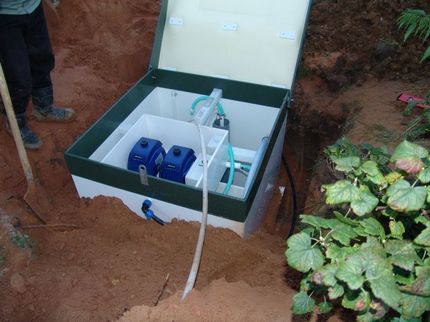
The place for the arrangement is also chosen so that when summing up the pipeline to minimize the number of turns. During operation of the system, solid inclusions will accumulate in them, complicating the flow of effluents.
The size of the pit is determined by focusing on the dimensions of the septic tank, while adding 50-60 cm in width and length. For example, for the Topas-5 model, the dimensions of which are 1000x1200x1400 mm, it will be necessary to dig a pit 1800x1800 mm in size with a depth of 2.4 meters.
Typically, such structures are relatively compact, so excavation can be done manually.
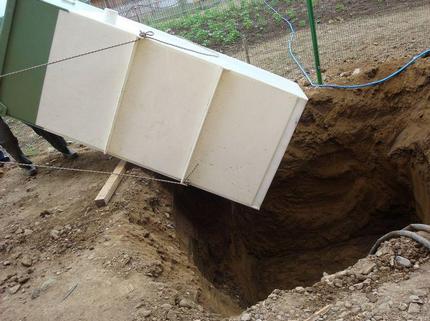
The depth of the pit is made at least 10 cm greater than the height of the installed structure.If the neck of the septic tank rises above the ground, then they take into account not the height, but the depth of immersion. Given the low occurrence of groundwater, it is enough to equip the bottom of the pit by backfilling and tamping sand.
With a high occurrence of groundwater, it is desirable, but not necessary, to concrete the bottom.
If it is supposed to lay a concrete base, when determining the depth of the pit should take into account the height of the fill.
The traditional installation scheme under normal geological and hydrogeological situations suggests that the station cover should rise above the ground by 15 - 18 cm.
Stage # 2 - arrangement of the bottom in areas with characteristic floods
If there is a chance of flooding the station, the bottom of the pit is arranged in a special way. It must first be carefully compacted and leveled, guided by the level. The prepared base is lined with a layer of sand, forming a "pillow" with a thickness of 15-20 mm.
The sand layer will raise the septic tank above the surface to a height of 15-20 cm. Thanks to this solution, you can prevent the flooding of the sewage treatment plant during floods and snowmelt. After all, the ingress of water can adversely affect the work of not only the compressor, but the entire system as a whole.
If groundwater comes close to the surface, it is advisable to strengthen the bottom of the pit with a sand-cement screed or concrete slab. To strengthen the loose walls of the pit pit, the pit is strengthened with a formwork made up of wooden boards or made of fine-mesh metal mesh.
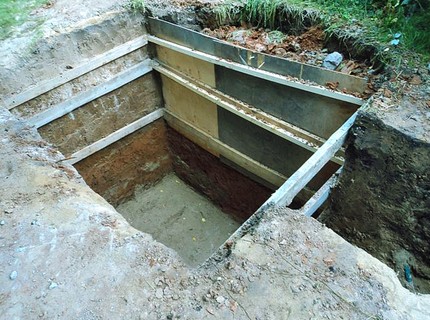
To bring the sewer networks, a ditch is dug, which will ensure the passage of the pipeline below the freezing point of the soil.
The bottom of the trench is leveled and rammed, providing an inclination angle of 3%. This is necessary to create conditions for the unimpeded discharge of wastewater towards the septic tank. The tamped bottom of the trench is lined with sand or gravel.
In parallel with this, a ditch is being prepared for laying a pipe that will discharge the treated effluents into filter well, body of water or any other receiving container. When tamping the bottom of the discharge ditch, the slope for the forced evacuation of the liquid can not be observed.
Stage # 3 - installation of a treatment plant
For immersion models with a numerical indicator of 5 and 6, you can do with the forces of three to four people. A larger model Topas-8 will have to be immersed, attracting small-scale mechanization.
Before the station is immersed in the pit, it is necessary to bring to the connection points a drain-receiving line and a cable passed through a corrugated PVC channel or HDPE pipe.
The body of the structure is tied with ropes and lowered into the pit. Ropes are transported through special eyelets during transportation.

The tank installed on the bottom is obligatory aligned horizontally with the vertical, being guided by the building level, since the septic tank is unacceptable. Correction of the position is performed by adding sand under it.
If a concrete slab is provided at the base of the foundation pit, the tank immediately after installation is secured with cables.
Topop Septics are supplied without pipes and openings for the entrance of the supply sewer line. To summarize the sewage system from home use Pvc pipe D110 mm or D160 mm. The hole for its input is cut out in fact, but so that between the bottom of the septic tank and the pipe is not less than 1.5 m.
The hole should be cut carefully, as it should repeat the profile of the incoming line as accurately as possible. After inserting the pipe into the hole, the joints are scalded using a welding rod.
In order to prevent freezing of the pipe section lying above the freezing level, it must be insulated with rolled foil material or with the help of a shell. Only after the input and arrangement of the communications inputs is the final filling of the foundation pit with sand performed.
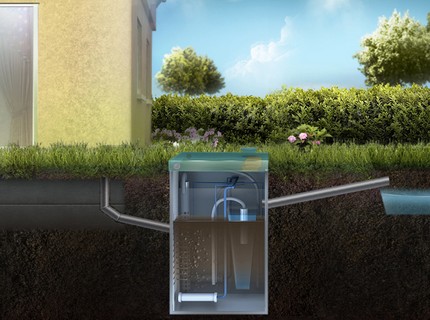
Stage # 4 - connecting electricity and normalizing pressure
At this stage, the septic tank is connected to the power cable. To power the building, a PVA electrical cable is used with a section of 3x1.5 square mm. To protect it from mechanical damage, use a corrugated pipe.

The electric cable can be placed in one trench together with a sewer pipe. The main thing is to ensure its tightness.
The filling of voids between the walls of the structure and the pit is performed in parallel with filling the tank with water. Thus, the process of equalizing the pressure of the partially hollow station and the surrounding soil is carried out.
The water level in the tank should be 15-20 cm higher than the height of the backfill. Work is carried out until the moment of complete filling.
To fill the pit with a septic tank, clean sand is used without clay inclusions and construction debris. As the voids are filled every 20-30 cm, the mixture should be rammed manually. The remaining 30 cm of space between the walls of the pit and the septic tank is filled with fertile soil.
Ditches with outlet and inlet pipes laid in them are also covered with sand and previously removed soil.
Design Maintenance Highlights
The service life of the Topas system is more than one dozen years. But the key to the smooth operation of the structure is its proper maintenance. The requirements for the operation of a treatment plant of any model are the same.

When operating such a treatment system, it is allowed if the wastewater contains residues of mild detergents and phosphate-free washing powders. The presence of residues of toilet paper in the wastewater will not do much harm.
When servicing the Topop septic tank, it should be borne in mind that it is strictly forbidden to dump into it:
- Spoiled vegetables and fruits.
- Residues from building materials, including sand.
- High bleach detergents.
- Automotive consumables.
- Remains of drug-based drugs.
- Rubber, film and other synthetic compounds that are not biodegradable.
It is also not recommended to discharge into the septic tank the water that has been purified using an oxidizing agent. If the operating rules are repeatedly violated, breakdowns are possible and then it will be required septic tank repair.
To avoid troubles, it is required, in addition to proper operation, to regularly carry out maintenance activities of the treatment plant.So, once a month it is necessary to clean the coarse filter. Once a quarter, remove spent sludge from the stabilizer. Replace the membrane annually.
Comprehensive preventive cleaning of the bottom and walls of the structure from sludge sludge should be carried out every three to four years.

Complete general cleaning of the septic tank, including checking the float mechanism and replacing the aerator, is carried out once every ten years.
Activities for the maintenance of the septic tank Topas in winter have their own characteristics. We examined them in detail in this article.
Conclusions and useful video on the topic
The principle of operation of the structure:
Septic tank installation guide:
Having correctly installed and launched the facility, as well as observing the above listed rules during its operation, you will be able to use the facilities of a sewage treatment plant that can serve uninterruptedly for several decades.
Have you installed the Tapas septic tank on your own site? Share your impressions of its operation, tell us, are you satisfied with this treatment plant? Leave your comments under our article, add a photo of your septic tank.
Or maybe you are just planning a purchase and you have questions? Ask them in the comment block - our expert will help you.

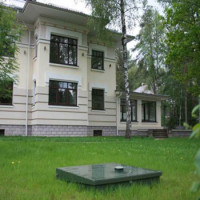 Repair of a septic tank "Topas": features of professional and self-service
Repair of a septic tank "Topas": features of professional and self-service  Rules for servicing a septic tank in winter: cleaning and maintenance
Rules for servicing a septic tank in winter: cleaning and maintenance 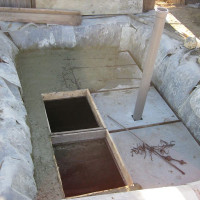 Do-it-yourself monolithic concrete septic tank: schemes and rules for arranging a concrete septic tank
Do-it-yourself monolithic concrete septic tank: schemes and rules for arranging a concrete septic tank 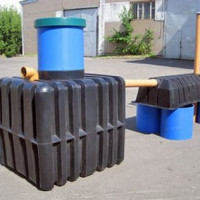 DIY septic tank installation: installation and maintenance instructions
DIY septic tank installation: installation and maintenance instructions 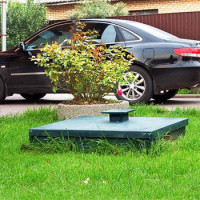 Overview of the septic tank for the cottage “Unilos Astra”: device, service rules, advantages and disadvantages
Overview of the septic tank for the cottage “Unilos Astra”: device, service rules, advantages and disadvantages  How is the Topop septic tank serviced in winter
How is the Topop septic tank serviced in winter  How much does it cost to connect gas to a private house: the price of organizing gas supply
How much does it cost to connect gas to a private house: the price of organizing gas supply  The best washing machines with dryer: model rating and customer tips
The best washing machines with dryer: model rating and customer tips  What is the color temperature of light and the nuances of choosing the temperature of the lamps to suit your needs
What is the color temperature of light and the nuances of choosing the temperature of the lamps to suit your needs  Replacement of a geyser in an apartment: replacement paperwork + basic norms and requirements
Replacement of a geyser in an apartment: replacement paperwork + basic norms and requirements